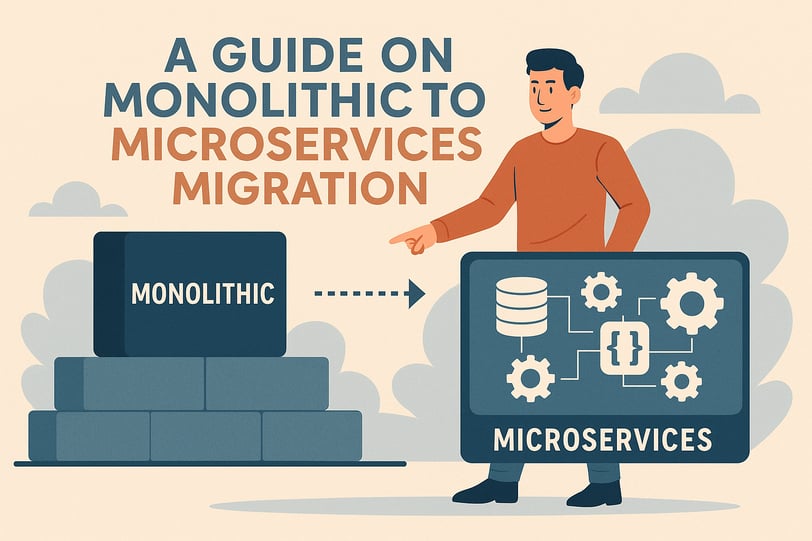
A Guide on Monolithic to Microservices Migration
The move from monolithic application architectures to microservices migration is an important trend in today’s software development. Monolithic systems have a combined database, client-side interfaces, and server-side application parts, which can become large and unbending over time. On the other hand, microservices architecture breaks down components. This allows for scalability and quicker deployment. As companies work to fulfill changing customer needs and business requirements, knowing how to carry out this migration well can change their software systems for the better.
CUSTOMISED SOFTWARE DEVELOPMENT
Key Highlights
Monolithic applications, with their tightly coupled dependencies, face challenges in scalability and adaptability, driving the need for microservices migration.
Microservices architecture facilitates incremental refactoring, enabling faster release cycles and improved flexibility.
Identifying service boundaries, leveraging asynchronous communication, and minimizing dependencies are vital steps in the migration process.
Transitioning requires modern CI/CD pipelines for automation and real-time observability to ensure consistent performance.
The benefits of microservices include enhanced scalability, load balancing, fault isolation, and greater system resilience.
Proper planning, data management, and security practices are critical for a successful migration.
Introduction
The move from monolithic application architectures to microservices migration is an important trend in today’s software development. Monolithic systems have a combined database, client-side interfaces, and server-side application parts, which can become large and unbending over time. On the other hand, microservices architecture breaks down components. This allows for scalability and quicker deployment. As companies work to fulfill changing customer needs and business requirements, knowing how to carry out this migration well can change their software systems for the better.
Steps for Migrating from Monolithic to Microservices
Moving from a big monolithic application to a microservices architecture requires careful thinking, planning, and many steps. Success relies on finding separate features, creating a detailed plan, and making changes over time with best practices. Important parts include designing clear service boundaries, using automation through CI/CD pipelines, and keeping track of everything continuously. During the migration process, focusing on the easiest services first helps with the early work. Tools like observability platforms make the transitions smoother and ensure everything works well.
1. Identify Decoupled Functionalities within the Monolith
Finding different functions inside the monolith is key to a successful migration. Teams should start by looking at the parts of the monolithic application. This helps to identify dependencies and their roles in business logic. They can find service boundaries with methods such as topology mapping, telemetry data, and checking request patterns.
Discovery tools, like observability platforms, can simplify this process. They give a clearer view of how different components are connected. This insight helps organizations lower risks when making code changes during decomposition.
Setting clear service boundaries helps separate functions tied to business areas. For instance, features like the checkout module in e-commerce can be good areas to decouple. Focusing on these parts not only builds a solid base for further development but also makes sure that dependencies do not slow down migration progress.
2. Establish a Microservices Architecture Blueprint
Creating a microservices architecture blueprint helps teams make a clear plan for change. They need to set up the microservices structure. This means aligning each service with important business tasks and following best practices, like keeping services loosely connected and able to be deployed on their own.
A good blueprint includes finding the APIs, setting service boundaries, and identifying dependencies. This process involves breaking down functions into smaller units. Each unit should work independently while communicating safely. They can do this through methods like asynchronous messaging or data synchronization.
Using integrated solutions can also improve results. For example, tools that combine dynamic analysis with static code checks provide valuable information on how to reshape existing dependencies. Planning with these detailed architectures helps teams spot possible bottlenecks and performance issues before they arise. With a smartly designed framework, organizations can build and deliver services gradually.
3. Begin with the Migration of the Least Complex Services
Using an incremental approach to migration means starting with the simplest services that have fewer connections in the monolith. This helps identify these services, leading to less risk. It also lets the development team practice and improve their methods for a successful migration.
Moving basic functions, like a simple notification system, shows that microservices architecture can work without affecting the entire application. By using strategies like the Strangler Fig pattern, we can gradually reduce dependencies while keeping the app’s performance steady during the change.
This step-by-step approach boosts teamwork by showing clear priorities. As each step is finished, teams feel more confident and are ready to handle more complex parts of the monolith. In the end, this method helps organizations avoid difficult challenges and builds up speed toward greater agility and flexibility.
4. Implement Continuous Integration and Continuous Deployment (CI/CD) for Each Service
Implementing continuous integration and continuous deployment (CI/CD) is very important when moving from a monolithic application to a microservices architecture. This method helps automate the testing and deployment of each service. It makes the process quicker and reduces delays. Each microservice needs its own pipeline. This allows for updates without waiting, which leads to faster release cycles. By using tools that manage dependencies and keep data consistency, teams can make the system work better. This also improves visibility into the entire system, which helps create a strong and scalable distributed system.
5. Monitor and Optimize the New Microservices Environment
Continuous monitoring is important in improving a new microservices environment. Teams need to check how well the system is doing with real-time observability tools. They should track metrics, traces, and logs for each service.
A single observability platform makes the process easier by providing clear visibility across different data points. This helps teams find latency issues or bottlenecks in services. By doing this, they can quickly fix problems to keep the application running well.
Optimization strategies also involve load balancing and resource scaling. This ensures that the application performs well, even when workloads change. Using insights from observability not only helps with smooth migration but also supports future growth and improvement of the microservices environment.
Key Benefits of Switching to Microservices
Moving to microservices gives better scalability, stronger system resilience, and faster software deployment than monolithic architectures. Independent services with clear APIs reduce the issues of tight coupling, allowing for more flexibility in different areas of functionality.
This shift allows teams to be more agile. They can adapt quickly to changes in business needs or market trends. Also, having autonomy in each microservice encourages fast innovation. It helps to keep user experiences running smoothly, even when problems arise.
Enhanced Scalability and Flexibility
Microservices architecture helps with scalability and flexibility by breaking tasks into smaller parts. Instead of changing a whole monolith, separate services can be scaled based on their specific needs.
Improved load balancing tools help with scalability by spreading tasks across different service instances. For instance, if the checkout service gets a lot of traffic during busy times, it can scale up without affecting other features or modules.
The separation between services allows teams to use new technologies without causing problems. This flexibility helps companies stay quick and effective in their development and how they respond to the market.
Improved Fault Isolation and System Resilience
Fault isolation is very important for system strength in microservices architecture. When one service fails, the other services keep running smoothly, which reduces big disruptions. In monolithic systems, one failure can lead to a complete shutdown.
The spread-out design of microservices helps teams quickly find faulty services using monitoring tools. They can solve problems by focusing on specific issues, rolling back any bad services without affecting the user experience.
Also, clear APIs and asynchronous communication patterns help keep data consistent while improving fault isolation. This builds strong and resilient software systems.
Faster Market Adaptation
Microservices architecture helps companies quickly adjust to changing market needs. It allows faster release cycles. With independent deployments, new features can be added without modifying the entire application. This helps businesses stay ahead in innovation.
The agility from microservices lets software teams react to user feedback fast. They can scale or improve core functions based on trends. This gives companies an advantage over their competitors.
Autonomous services make development easier. This gives organizations the flexibility to apply new technologies and methods. As a result, they can continue to grow in fast-changing markets.
Common Challenges in the Migration Process
Moving from a monolith to a microservices architecture has various challenges. One major issue is keeping data consistent among different services. Additionally, communication between services can get complicated.
Another challenge is rethinking security actions for a system that is spread out. When breaking up the functions of a monolith, there can be more obstacles. It may also be hard to keep performance levels when the application gets more complex.
To handle these issues, careful planning is necessary. Strong monitoring and thoughtful design of the infrastructure will help make the change successful.
Handling Data Consistency Across Services
Keeping data consistent can be the hardest part of moving to microservices. Monolithic applications use one central database. In contrast, microservices architecture uses many databases, each designed for specific services.
Teams need to use asynchronous communication and data synchronization methods. These help maintain data integrity in the distributed system. Techniques like eventual consistency and replication allow for consistency while avoiding conflicts.
Smart observability tools can track how databases interact. This ensures smooth data flow and manages service-specific information without creating bottlenecks.
Managing Service-to-Service Communication
Service-to-service communication is very important in microservices architecture. It helps to keep everything running smoothly. It is crucial to have strong communication methods to tackle latency issues caused by network dependencies.
Using asynchronous messaging systems makes it easier for services to talk to each other. These systems let services share information without needing real-time processing. Teams can use REST APIs, gRPC, or message queues to improve this communication.
Having standard methods and shared gateways helps to create dependable communication channels. This also reduces disruptions. A steady architectural method keeps things integrated well during the migration process, ensuring everything stays consistent.
Ensuring Security in a Distributed Environment
Distributed microservices architectures need special security precautions because they are decentralized. Using strong authentication methods like OAuth helps protect services from unauthorized access.
Access control systems must be set up carefully to keep data safe across various service instances. Tools that provide security monitoring and real-time alerts make the system more reliable.
Good encryption practices protect communication between microservices and ensure data integrity. By focusing on security during each step of migration, organizations can fix vulnerabilities while keeping operations running smoothly.
Conclusion
In conclusion, moving from a monolithic architecture to microservices has many advantages. These benefits include better scalability, flexibility, and fault isolation. To make this transition easier, start with separate functions and set up a strong CI/CD pipeline. It’s important to tackle issues like data consistency and service communication. This will help ensure your migration process goes smoothly. As you begin, keep in mind that microservices can make your system stronger and more adaptable in the changing tech world. If you want to take this next step, contact us for expert help that is right for you.
Frequently Asked Questions
What are the initial steps to consider before starting migration?
Before moving to microservices, get to know the monolith’s inner workings. Be clear about service boundaries and create a plan for the microservices architecture. Begin by making small changes. Focus on the easiest tasks first to ensure a successful migration. Also, make sure to add strong CI/CD pipelines during this process.
How does microservices architecture enhance system resilience?
Microservices architecture makes systems more reliable by isolating faults. If one service fails, the other services keep working. Tools like load balancing and distributed systems increase flexibility and scalability. This helps to lower downtime and provides better performance overall.
What are the best practices for data management in microservices?
The best practices for managing data in microservices involve a few important steps. First, keep data consistency by using asynchronous communication. Second, use distributed database designs. Third, apply replication methods to ensure data integrity. Also, observability tools are useful. They help track smooth data synchronization between services.
Can microservices and monolithic architectures coexist during transition?
Yes, microservices and monolithic architectures can work together during migration by using the strangler pattern. Teams can slowly change functions of the monolith to microservices. This process keeps disruptions low. Gradual changes help with stability and make the user experience better.



